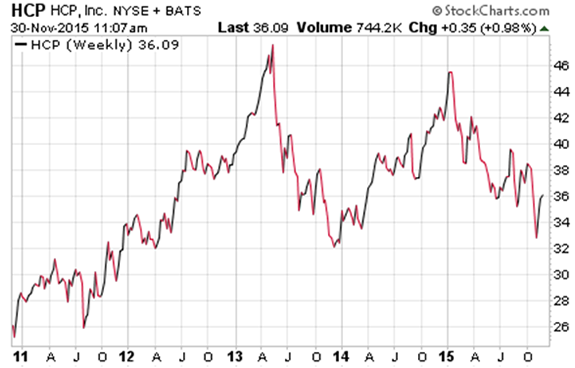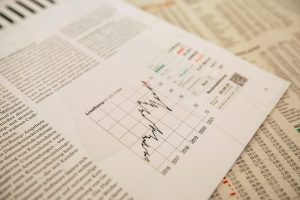Dividend Aristocrats That Dodge Disasters
My good friend Large Lou Sapino is an expert on vodka.
Not long ago he asked me about Russian stocks.
(A few weeks ago I told him that investing in Russian stocks is a dividend disaster.)
Lou also happens to be a very smart real estate investor.
He told me that investing in land out on the edge of town and waiting for the town to sprawl out has been a good strategy for him.
“I buy this dirt for peanuts, sit back, and wait.”
So when I told Large Lou that investing in dividend stocks is pretty much the same thing, he wanted to know more. The patient behavior was something he could relate to.
“But here’s the thing, Lou,” I told him. “You can’t always buy one of the best dividend stocks for peanuts.”
I explained that the best dividend paying stocks are often found on the lineup of the S&P 500 Dividend Aristocrats. These are large cap stocks that have been paying a growing dividend for at least the past 25 years.
This kind of performance comes with a price. You’re paying a premium for the hope that the company can make it through tough times and still have enough money to pay the dividend.
To avoid a dividend disaster, you need to size up the financial health of the company. If revenues are soft, and if profits are shrinking, there could be trouble ahead.
So you’ve got this balancing act.
You’re paying a premium for a stock that’s supposedly safe because it’s a reliable dividend-payer.
But you’ve also got the possibility that today’s dependable Dividend Aristocrat could be tomorrow’s dog if it cuts the dividend and is thrown off the list.
How To Size Up The Health Of A Dividend Aristocrat
First, go to the financial statements. Look at the income statement and the balance sheet.
With the big, global companies you usually find on the S&P 500, this can be difficult. It’s not always easy to see where a company is making money and where it’s keeping its money.
A company like Colgate Palmolive $CL, which does business all over the world, can be tricky to decode.
A company like Consolidated Edison $ED, which does most of its business in New York, is more straightforward.
Each one of these stocks is a Dividend Aristocrat. Colgate Palmolive has been paying a growing dividend since 1964. Consolidated Edison has been paying a growing dividend since 1975.
Is there a good reason to think either one of these stocks is about to fly off the rails and cut the dividend?
Not really. But they’re not exactly cheap.
What’s a reasonable price to pay based on the P/E ratio (price earnings ratio)? Right now, the average for the S&P 500 stocks is 19.
Colgate Palmolive has a P/E ratio of 24.65. Consolidated Edison has a P/E ratio of 16.91.
The Relationship Between Stock Price And Dividend Growth
My friend Large Lou Sapino won’t pick up either one of these dividend stocks for peanuts.
But he might like the fact that Consolidated Edison is cheaper than the overall market.
Does this discount mean investors think the stock is in trouble and could be on the verge of slashing the dividend?
Probably not.
It’s more a reflection of how investors think the stock price will perform. Utility stocks aren’t high-fliers. Chances are, there won’t be a stunning run-up in the price of the Consolidated Edison stock.
Consolidated Edison stock is priced at about the same level as most utility stocks.
Something else this low P/E ratio could tell us… investors don’t expect much in the rate of dividend growth for the stock.
Dividend growth for $ED was 2.4% in 2014 and 1.7% in 2013.
Colgate’s dividend growth for 2014 was 6.8% and 9.0% for 2013. This stronger dividend growth is one of the reasons why you pay more for Colgate than you do for Consolidated Edison.
See the balancing act?
Take a look at this stuff and you’ll get a better handle on how a stock behaves and what kind of early warning signals could let you know it’s about to cut the dividend.
Is This Dividend Aristocrat Heading For Trouble?
The S&P Dividend Aristocrat that pays the highest yield right now is a REIT, a Real Estate Investment Trust.
HCP $HCP pays a lofty yield of 6.1%. It invests in senior housing communities, medical buildings, medical labs, hospitals, and nursing facilities both here in the U.S. an in the U.K.
One of the reasons why the yield is high… the stock price has been sliding this year. Take a look.

Does the sliding stock price, the unusually high yield for a Dividend Aristocrat, and the high dividend payout ratio, add up to signal that $HCP is headed for a dividend cut? Probably not.
That’s because we’re dealing with a REIT, which by law needs to plow a large share of profits into dividends to avoid paying high taxes.
But at 71.5%, the dividend payout ratio for HCP is definitely on the high side.
It’s one of the dividend payout ratio essentials that are good to keep an eye on.
Despite the high yield, which may be a bit unsettling…
This REIT has been rewarding dividend investors with dividend growth for 30 years.
And that’s one of the beautiful things about the S&P 500 Dividend Aristocrats. Their track record – a history that stretches back for decades.
It’s this kind of dividend history that gives you an advantage because dividend history helps you pull in higher income.
For my friend Large Lou Sapino, the bottom feeding real estate investor, higher income from dividend stocks might not be dirt cheap.
But it’s not a bad way to pull in a few extra dollars.
Cordially,
Paul Duke
Note: Paul Duke writes and edits DividendStocksResearch.com. Sign up for our free dividend reports and dividend newsletter at https://www.dividendstocksresearch.com/free-sign-up. We’ll show you how to create regular income by investing in dividend stocks, easily, step-by-step.
Category: Dividend Basics





